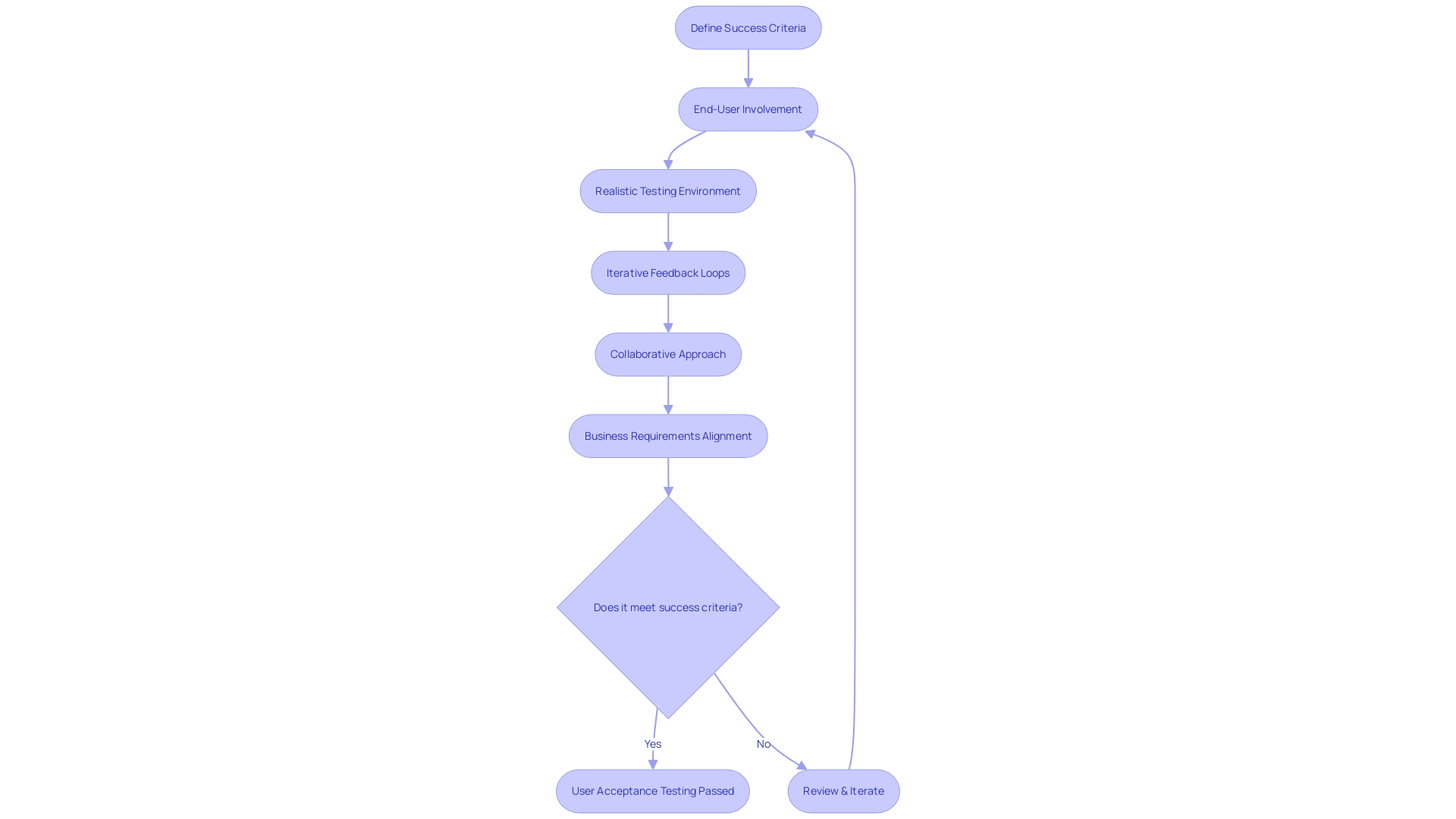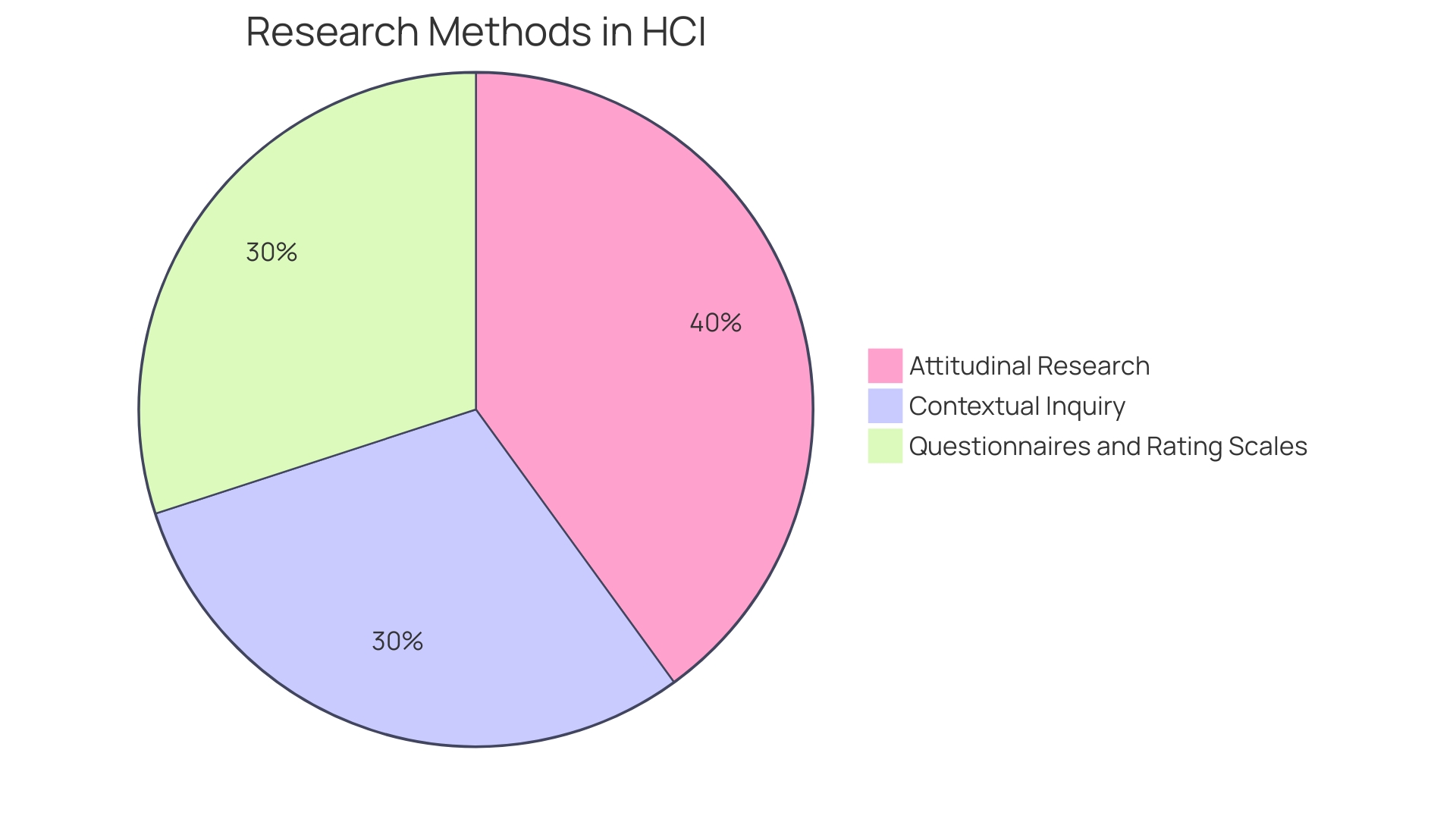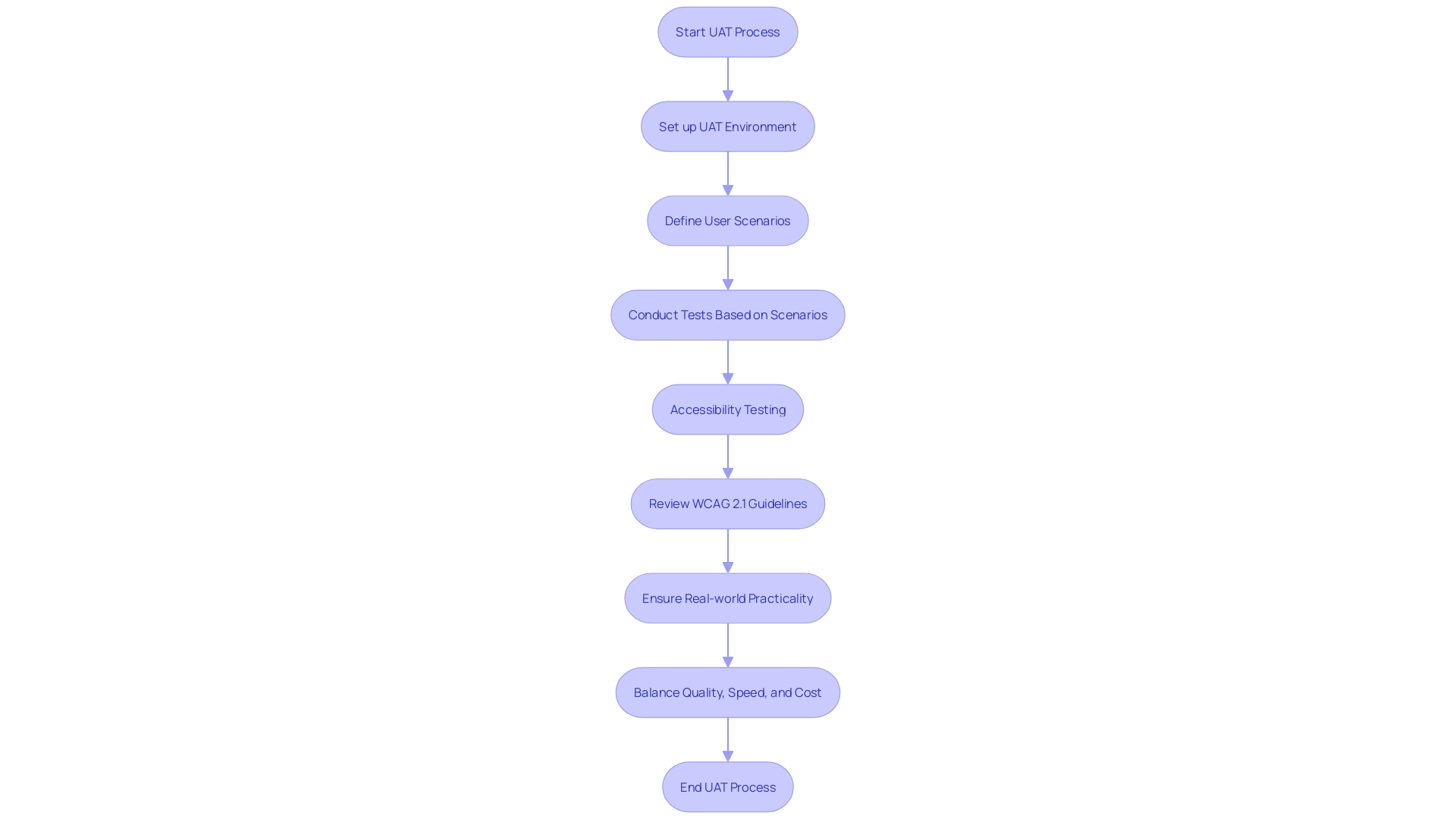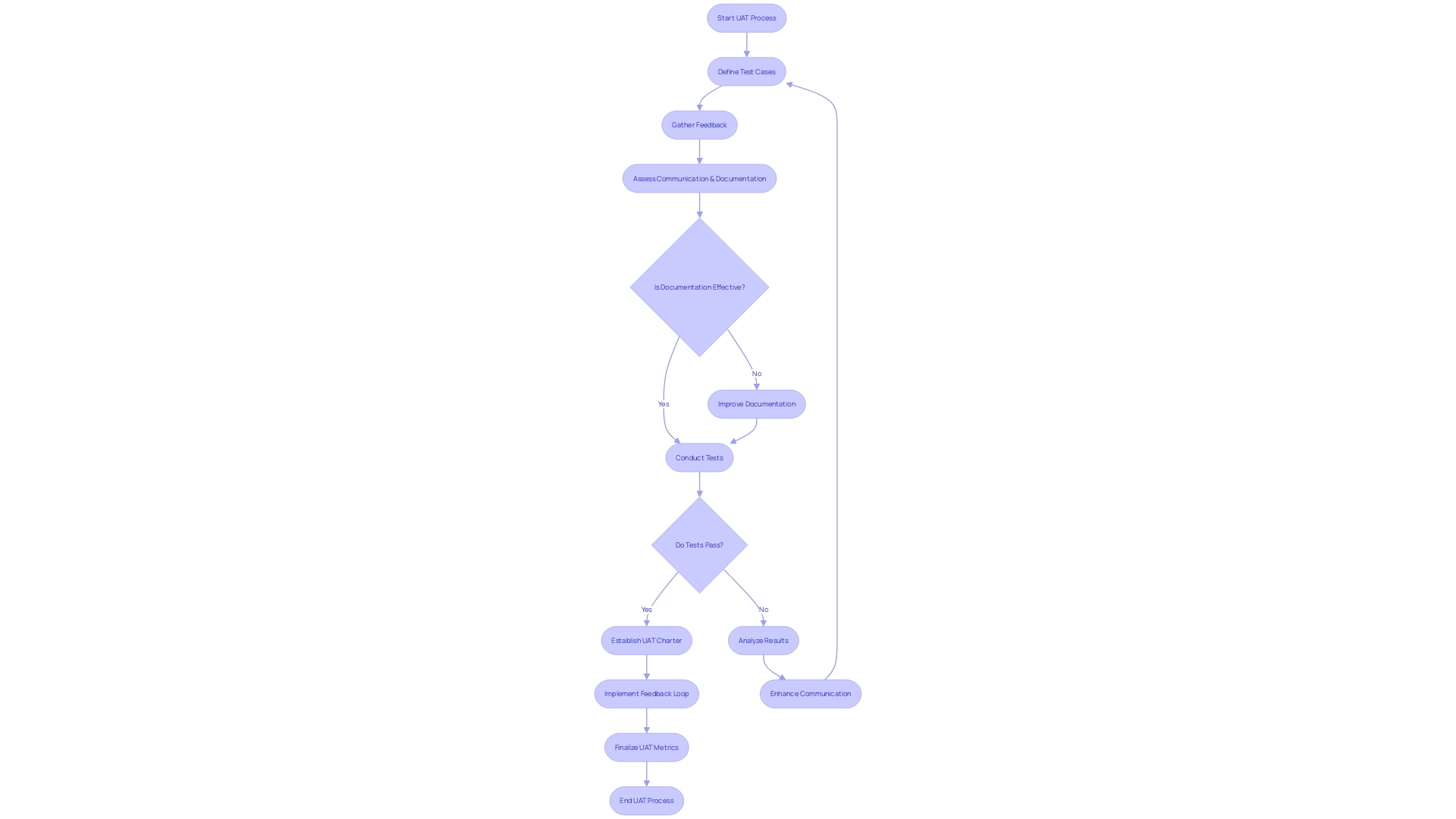Introduction
User Acceptance Testing (UAT) serves as the final validation step in the software development life cycle, where end-users test the application to ensure it aligns with their business requirements. This critical phase goes beyond functionality, focusing on usability and reliability to ensure the product is primed for real-world application. With its ability to flag potential issues and defects early on, UAT saves valuable time and resources, preventing larger complications post-release.
Additionally, UAT evaluates accessibility, ensuring inclusivity and compliance with legal standards. By incorporating key principles such as defining success criteria, involving end-users, and aligning with business requirements, UAT enhances the likelihood of a successful software launch. Thorough test case preparation and execution, along with a realistic test environment, contribute to the effectiveness of UAT.
Clear communication and documentation play a vital role in ensuring a successful UAT process, facilitating issue resolution and system improvement. Finally, continuous improvement is crucial in UAT, utilizing feedback to refine and enhance the system, ultimately delivering superior software solutions.
Purpose and Goals of UAT
User Acceptance Testing (UAT) represents the final validation step in the software development life cycle, where end-users test the application to certify it aligns with their business requirements. This critical phase focuses not only on verifying functionality but also on assessing usability and reliability, ensuring the product is primed for real-world application. The process involves users who may be consumers of the software or stakeholders who have initiated its development, bringing a business-centric perspective to the testing activities.
The significance of UAT lies in its ability to flag any potential issues or defects, facilitating corrections before the software's deployment. This methodical approach to testing is imperative to uncover a range of bugs, from trivial syntax errors to complex logical issues that could potentially lead to systemic failures. Addressing these defects early on saves valuable time and resources, preventing them from turning into larger complications post-release.
Furthermore, ensuring the software's functionality corresponds to the end-user's requirements is essential, as detailed in the World Quality Report, which monitors trends in software quality and testing.
Accessibility also forms a crucial part of the testing process. It evaluates how individuals with disabilities can interact with the software, adhering to standards such as the Web Content Accessibility Guidelines (WCAG) and Section 508. Despite the challenges cited by organizations, including time constraints and resource limitations, accessibility remains a pivotal aspect of UAT, ensuring inclusivity and compliance with legal standards.
Key Principles of UAT
User Acceptance Testing (UAT) serves as a critical phase in software development, bridging the gap between the developers' vision and the end-users' needs. It's a process where the intended users validate the software against business requirements to ensure it delivers the expected value and performance. UAT's effectiveness hinges on several core principles:
-
Defining Success Criteria: Success in UAT is not just about ticking off a list of functionalities; it's about ensuring the software performs tasks in real-world scenarios as intended. This involves a clear understanding of what success looks like, which goes beyond mere technical performance to include usability, reliability, and user satisfaction.
-
End-User Involvement: The active participation of the end-user is paramount, as they bring a business-centric perspective to the table. Their hands-on testing provides insights that are often overlooked by developers, highlighting real-world usage and expectations.
-
Realistic Testing Environments: To truly gauge how software will perform, UAT should be conducted in conditions that closely mimic the production environment. This includes realistic data, user behavior, and operating conditions to uncover any potential issues that might arise post-deployment.
-
Iterative Feedback Loops: UAT is not a one-time event but a series of tests and feedback cycles. User feedback is invaluable for fine-tuning the product, ensuring that each iteration brings the software closer to the ideal user experience.
-
Collaborative Approach: Effective UAT requires a collaborative effort between the development team and the users. This partnership ensures that feedback is accurately interpreted and that solutions align with user expectations.
-
Business Requirements Alignment: Every test case in UAT should trace back to a business requirement. This ensures that the software not only works technically but also fulfills its intended business purpose.
Incorporating these principles into the UAT phase can significantly enhance the likelihood of a successful software launch, ensuring that the final product not only meets technical specifications but also delivers a satisfying user experience.

Involvement of End-Users and Stakeholders
The essence of User Acceptance Testing (UAT) is deeply rooted in the collaborative effort between end-users and stakeholders. It's a process where their engagement is not just beneficial but crucial, ensuring the system is tailored to their unique requirements. The synergy begins in the early stages of UAT, where feedback and insight shape the system into one that truly resonates with users.
For instance, during a brainstorming session at the ITS all-staff meeting, participants designed hypothetical AI tools with specific user-centric functionalities, such as a smart solution search and a concise summary generator. These examples underscore the value of understanding the end-user's environment and the importance of their input in creating relevant and efficient systems.
Furthermore, the success of UAT hinges on thorough documentation of use cases, as they serve as a blueprint for system requirements. They encapsulate the user's goals and the pathways to achieve them, including alternative scenarios. This meticulous approach to capturing system requirements was emphasized by the Object Management Group's UML specification and industry experts Ivar Jacobson and Alistair Cockburn.
Real-world applications of UAT are evident in cases like the transformation project led by Mehmet Kaynakci, where the integration of finely customized systems was a priority. The challenge was to maintain the systems' core strengths while enabling seamless interaction. This reflects the complexity and importance of validating software in environments where it will be utilized, as noted in HCI research.
The integration of user feedback is pivotal in refining software, enhancing user experience, and reducing the risk of post-release defects.
In the realm of mobile UX, statistics reveal that users prioritize functionality over aesthetics. Over 50% of users are unlikely to purchase from a brand with a poorly designed mobile site, while mobile sites that load in two seconds or less see a 15% higher conversion rate. These insights further strengthen the argument for incorporating real-user feedback in the testing phase, ensuring the system is not only functional but also aligns with user preferences for speed and efficiency.
This strategic approach to UAT can lead to products that are not only successful in the market but also championed by users for their intuitiveness and ease of use.

Test Case Preparation and Execution
User Acceptance Testing (UAT) is the capstone of the software development process, designed to ensure that the final product aligns with the end-user's expectations and business requirements. It is a critical phase where the real-world scenarios are simulated by the end-users themselves to validate the system's functionality and performance. The construction and execution of test cases serve as the backbone of this phase.
Each test case is meticulously designed to cover a specific aspect of the application, encompassing a variety of inputs, conditions, and expected outcomes to verify that every feature operates as intended.
In practice, UAT is not just about uncovering defects but also about confirming that the software delivers a user experience that meets the approval criteria set forth by the stakeholders. This hands-on validation process is often carried out by users who possess a comprehensive understanding of the business context, making their feedback invaluable. For instance, a user testing a database management tool would perform actions and evaluate outcomes based on their expertise and day-to-day interactions with similar systems.
UAT's significance is further underscored by statistical insights, which highlight its role as the definitive stage where the software must prove its readiness for deployment. A successful UAT cycle is indicative of a product that is ready to be introduced to the market, having met the stringent standards of those who will ultimately use it.
Moreover, recent developments in the industry, such as the establishment of advanced testing facilities by companies like UL Solutions, exemplify the ongoing commitment to elevating the testing processes. These facilities, equipped to accommodate various testing methodologies, underscore the importance of adaptability and precision in UAT environments.
Well-structured test cases, therefore, are indispensable tools that guide testers through the validation process, ensuring a systematic and thorough examination of the application. As highlighted by experts in the field, the robustness of test cases directly correlates to the quality and reliability of the software, making them an essential component of the UAT phase.
Realistic Test Environment
User Acceptance Testing (UAT) is a pivotal phase in the software development cycle, where the real-world practicality and readiness of a system are put to the test. To ensure its effectiveness, UAT should mirror the production environment as closely as possible, enabling the detection and resolution of any potential issues prior to live deployment. This approach to testing helps in uncovering discrepancies that might not be evident in less comprehensive testing stages.
A well-constructed UAT environment incorporates all the necessary data, configurations, and integrations that an end-user would encounter. This includes considering various user scenarios and workflows to validate the system against business requirements and user needs. As observed in the implementation stories shared by industry professionals, like Markos Fragkakis from Workable, the experience of fine-tuning such environments can provide valuable insights for others aiming to enhance their continuous integration (CI) processes.
The significance of a realistic UAT environment is further emphasized by recent industry news, highlighting the challenges in accessibility testing. With rigorous UAT, software can be vetted for compliance with standards like the WCAG and Section 508, ensuring a seamless experience for all users, including those with disabilities.
Statistics reinforce the importance of modern testing methodologies, revealing a shift in perception from viewing QA as a cost center to recognizing its potential for substantial cost savings and ROI. The debate between manual and in-house testing underlines the hidden costs associated with each, advocating for a more strategic approach to balancing quality, speed, and financial prudence in the testing process.
Ultimately, UAT is not just about ticking off a checklist; it's an art and a science, as echoed in the words of industry experts. It involves critical thinking, risk investigation, and a healthy dose of professional skepticism to ensure that when the software finally meets its users, it not only functions but thrives in the real world.

Clear Communication and Documentation
The cornerstone of a successful User Acceptance Testing (UAT) process is not just the rigorous testing but also the meticulous documentation and communication that accompany it. A prime example of effective communication and documentation in action is seen in the digital technology adoption processes within healthcare systems, such as the NHS. Before any technology is introduced, a thorough initial assessment is conducted, which includes the use of questionnaires to understand the specific needs and justifications for the technology.
This highlights the importance of gathering detailed information and maintaining clear records, which are essential for analyzing the suitability and impact of the technology.
Moreover, the concept of a Research Group Charter is highly relevant to the UAT process. Charters serve as a formal declaration of expectations, standards, and responsibilities. In the context of UAT, a charter could establish clear guidelines for communication, documentation, and issue resolution, ensuring that every member of the testing team understands their role and the collective goals of the project.
In the realm of communication theory, the Transactional Model emphasizes the dynamic exchange of messages, where feedback is crucial. This model can be applied to UAT, where feedback loops between testers, developers, and stakeholders are integral for refining the software and resolving any issues. The process mirrors the interaction between healthcare providers and patients, where effective communication strategies are paramount.
For instance, research by Artera shows that broken communication exchanges can lead to a significant increase in workload for healthcare staff, underscoring the need for seamless communication channels.
UAT's success is also reflected in the metrics it influences. For example, poor communication can lead to substantial revenue loss for organizations, as evidenced by Artera's findings that indicate a 10-30% revenue loss due to ineffective patient communication strategies. Similarly, UAT outcomes directly impact a software's stability and user satisfaction, which in turn affect an organization's financial health and reputation.
Therefore, in the UAT process, clear and structured communication, coupled with comprehensive documentation, is not just beneficial but crucial for the identification and resolution of issues, leading to a more stable and user-friendly software product. It is these practices that enable efficient collaboration and contribute to the overarching goal of delivering technology that meets user needs and expectations.

Continuous Improvement
User Acceptance Testing (UAT) is an essential phase in the software development lifecycle, ensuring that the end product aligns with business requirements and provides a satisfactory user experience. It's a process that benefits greatly from a continuous improvement mindset, utilizing feedback from each testing cycle to refine and enhance the system. Through iteration, UAT evolves into a more effective and efficient practice, leading to the delivery of superior software solutions.
For instance, AT&T's historical practices in regulated industries highlight the importance of continuous evolution to overcome entrenched systems. By acknowledging employee frustrations through surveys and taking action, they demonstrated the significance of adapting and improving processes.
A case study from the Department of Electronic & Electrical Engineering at a university illustrates how systematic tracking of student feedback during personal tutorials can lead to improvements in educational systems. This proactive approach to collecting and implementing feedback is akin to the principles of effective UAT.
Furthermore, the transformation of UHealth's ServiceNow platform showcases the necessity of distinct solutions for academic and healthcare domains, emphasizing the importance of integration and differentiation in systems development—principles that are equally applicable to UAT.
Recent insights suggest that the inclusion of real user feedback during UAT can significantly enhance the quality of the final product. With the understanding that most new tech products face high failure rates, a robust UAT process serves as a crucial buffer, ensuring that the product meets user expectations before its release.
Statistical analyses reinforce the value of ideation and product thinking in the realm of tech development. By adopting a structured approach to UAT—envisioning strategy, discovering through analysis and design, and delivering at scale—companies can achieve better outcomes and higher user satisfaction.
In conclusion, UAT is far from a one-off task; it's a dynamic process that thrives on user feedback and continuous refinement. By learning from past experiences and embracing change, the UAT process not only meets but exceeds the ever-evolving demands of the software industry.
Conclusion
User Acceptance Testing (UAT) is a critical phase in the software development life cycle, ensuring that the application aligns with end-users' business requirements and delivers a satisfactory user experience. Thorough test case preparation, realistic testing environments, and clear communication contribute to the effectiveness of UAT.
Involving end-users and stakeholders is crucial, as they bring a business-centric perspective and provide valuable feedback to refine the software. Thorough documentation of use cases ensures that the software fulfills its intended purpose and adheres to accessibility standards.
Continuous improvement is integral to UAT, utilizing feedback to refine and enhance the system. By learning from past experiences and embracing change, UAT meets the evolving demands of the software industry.
In conclusion, UAT is a dynamic process that ensures the application's alignment with business requirements, usability, and accessibility. By incorporating key principles, involving end-users, and continuously refining the system, UAT enhances the likelihood of a successful software launch.





